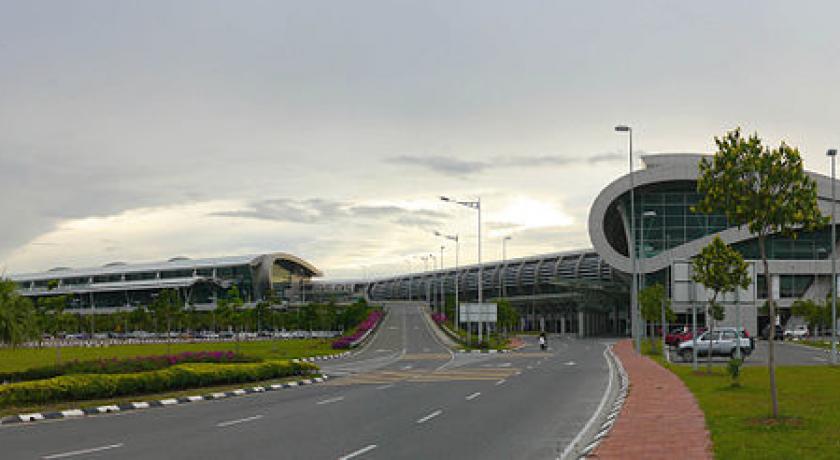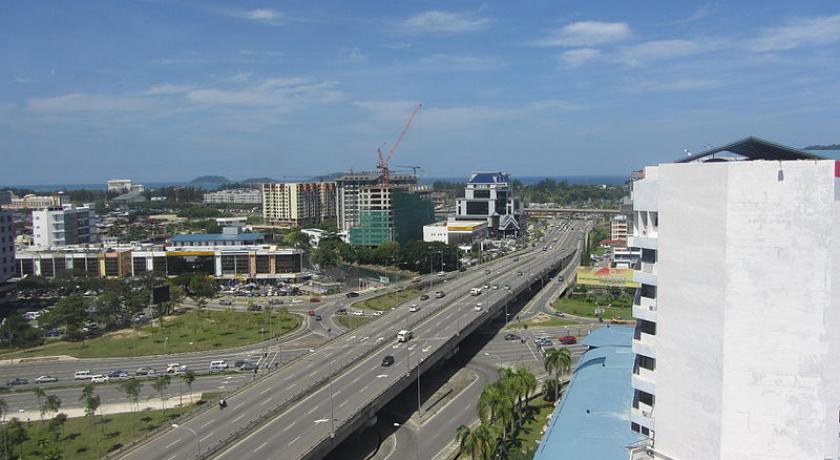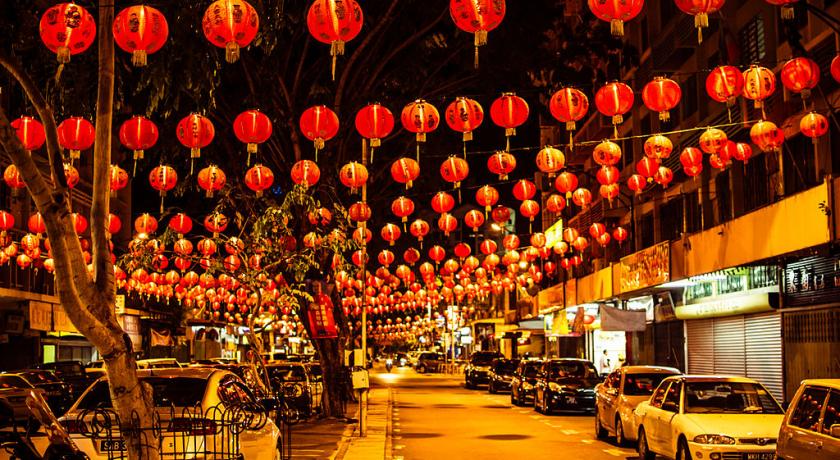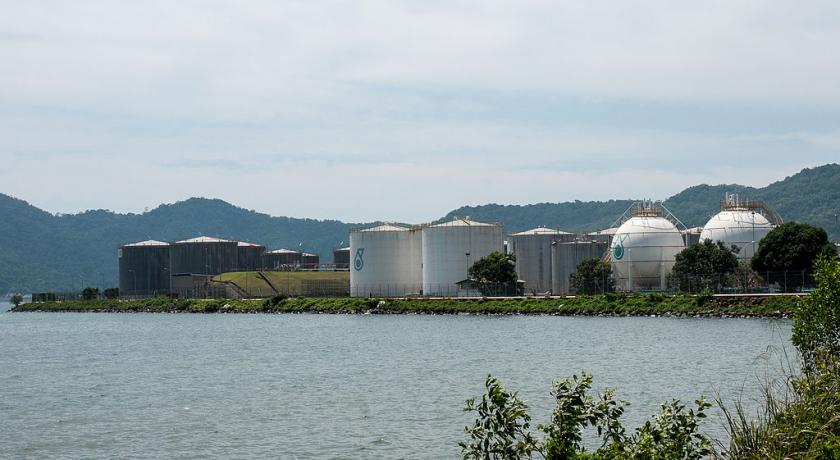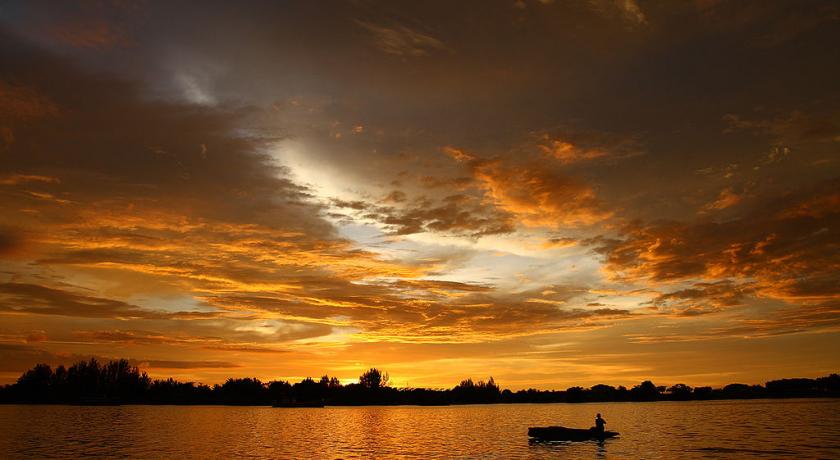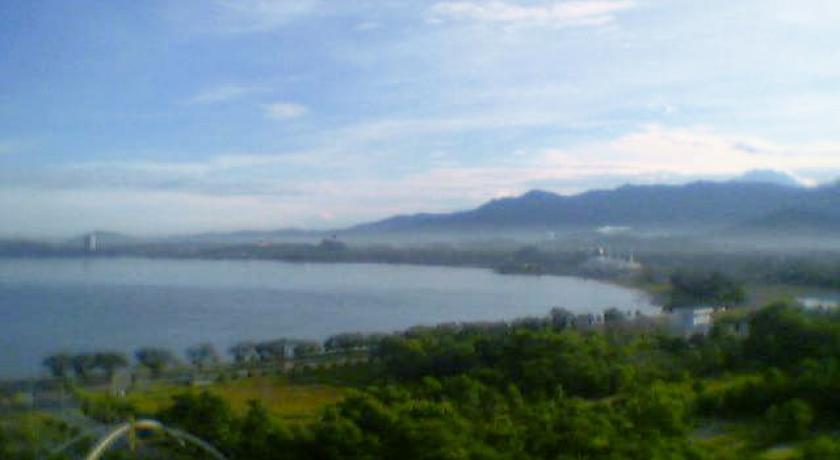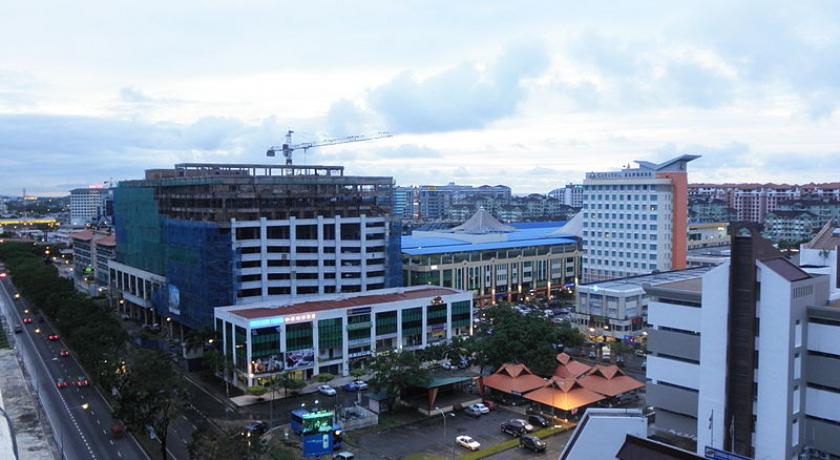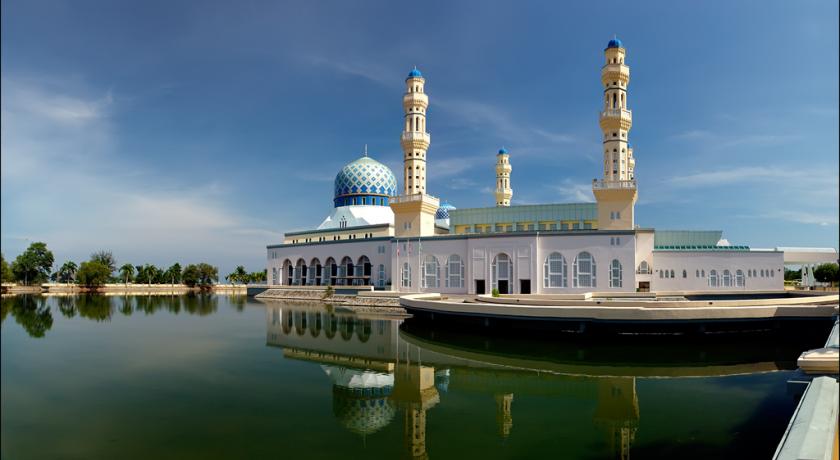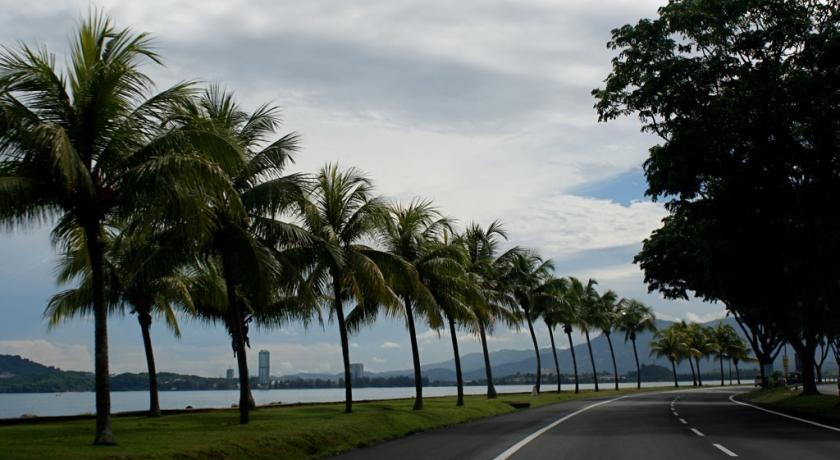Description
Kota Kinabalu
(Malaysian pronunciation: [ˈkota kinaˈbalu], Jawi: کوتا کينا بالو, Chinese: 亚庇; pinyin: Yàbì), formerly known as Jesselton, is the capital of the state of Sabah, Malaysia. It is also the capital of the West Coast Division of Sabah. The city is located on the northwest coast of Borneo facing the South China Sea. The Tunku Abdul Rahman National Park lies to its west and Mount Kinabalu, which gave the city its name, is located to its east. Kota Kinabalu has a population of 452,058 and, including the adjacent Penampang and Putatan districts, the metro area has an estimated population of 628,725.
Kota Kinabalu is often known as KK both in Malaysia and internationally. It is a major fishing destination and a popular gateway for travelers visiting Sabah and Borneo. Kinabalu Park is located about 90 kilometers from the city and there are many other tourist attractions in and around the city. Kota Kinabalu is also one of the major industrial and commercial centers of East Malaysia. These two factors combine to make Kota Kinabalu one of the fastest growing cities in Malaysia.
Etymology
Kota Kinabalu is named after Mount Kinabalu, which is situated about 50 kilometers east-northeast of the city. Kinabalu is derived from the name Aki Nabalu meaning the "revered place of the dead." Aki means "ancestors" or "grandfather", and Nabalu is a name for the mountain in the Dusun language. There is also a source claiming that the term originated from Ki Nabalu, Kimeaning "have" or "exist", and Nabalu meaning "spirit of the dead".
Kota is a Malay word for a "fort", "town", or a "city". It is also used formally in a few other Malaysian towns and cities, for example, Kota Bharu, Kota Tinggi, and Kota Kemuning. It can also be used informally to refer to any towns or cities. Hence, a direct translation of the name Kota Kinabalu into English would be "City of Kinabalu" or "Kinabalu City".
Wendy Law Suart wrote in her book on North Borneo, The Lingering Eye, "there is in the Sabah State Museum a Dutch map of Borneo and the Celebes dated 1657 in which the settlement where Jesselton was to stand is clearly labeled Api Api. It may have some connection with the seaside tree with breathing roots that bears the same name".
Original names
Besides Jesselton, there have been a number of other theories regarding the origins of the original name for Kota Kinabalu. The most popular, as mentioned above, is Api-Api, or simply Api, which is a Malay word meaning 'Fire'. There are claims, however, that Kota Kinabalu was actually named after a nearby river called Sungai Api-Api. In Chinese, the city is still known as 'Api', which is the Hakka pronunciation for 亚庇 (Simplified Chinese; Traditional Chinese: 亞庇; Pinyin: yà bì).
Besides Api-Api, another suggested historical name is Deasoka, which roughly means "below the coconut tree" in the Bajau language. The Bajau locals purportedly used this name to refer to a village in the southern part of the city which was filled with coconut trees. Another name was Singgah Mata which literally means "transit eye", but can be loosely translated as "pleasing to the eye". It is a name purportedly given by fishermen from Gaya Island referring to the strip of land which today is downtown Kota Kinabalu. Today, all these names have been immortalised as names of streets or buildings around the city. Some examples are Lintasan Deasoka, Api-Api Centre and Singgah Mata Street.
History
Since the 15th century, the area of Jesselton was under the influence of the Bruneian Empire. In the late 1800s, the British North Borneo Company (BNBC) began to establish colonies throughout North Borneo. In 1882, BNBC founded a small settlement in the area known as Gaya Bay, which was already inhabited by Bajau people. The first settlement was on Gaya Island. In 1897, this first settlement was burned and destroyed by the indigenous Bajau-Suluk freedom fighter Mat Salleh.
After the destruction, BNBC decided to relocate the settlement to the more easily defended mainland at Gantian Bay (now Sepanggar Bay) in 1898. However that location was found to be unsuitable and in July 1899, Mr. Henry Walker, a Land Commissioner, identified a 30 acres (12 ha) site opposite Gaya Island as a replacement for Gantian. This fishing village named Api-Api (see Original names) was chosen due to its proximity to the North Borneo Railway and its natural port that provided good anchorage, which was up to 24 feet deep. By the end of 1899, construction had started on shop lots, a pier and government buildings. This new administrative centre was renamed Jesselton after Sir Charles Jessel, who was the then Vice-Chairman of BNBC.
Eventually, Jesselton became a major trading post of North Borneo, dealing in rubber, rattan, honey, and wax. The North Borneo Railway was used to transport goods to the Jesselton harbour. The Malay and Bajau uprisings during those times were not uncommon, and BNBC worked to quell the long-standing threat of piracy in the region.
Jesselton suffered large destruction when it was razed by the British during their retreat from the Japanese and suffered more destruction when the Allies bombed it in 1945. After the Japanese takeover of Borneo, it was again renamed Api. Several rebellions against the Japanese military administration took place in Api. One major rebellion occurred on 10 October 1943 by a group called Kinabalu Guerrillas, consisting of local inhabitants. Japanese forces quelled the rebellion after its leader, Albert Kwok, was arrested and executed in 1944. At the later stages of the war, what remained of the town was destroyed again by Allied bombings day and night for over six months as part of the Borneo Campaign in 1945, leaving only three buildings standing. The war in North Borneo ended with the official surrender of the Japanese 37th Army by Lieutenant General Baba Masao in Labuan on 10 September 1945.
After the war on the edge of bankruptcy, the British North Borneo Company returned to administer Jesselton but was unable to finance the huge costs of reconstruction. They gave control of North Borneo to the British Crown on 18 July 1946. The new colonial government elected to rebuild Jesselton as the capital of North Borneo instead of Sandakan, which had also been destroyed by the war. The Crown Colony administration designed a plan, later known as the "Colonial Office Reconstruction and Development Plan for North Borneo: 1948–1955”, to rebuild North Borneo. This plan provided £6,051,939 for the rebuilding of infrastructure in North Borneo.
When the Crown Colony of North Borneo together with Sarawak, Singapore and the Federation of Malaya formed the Federation of Malaysia in 1963, it became known as Sabah, and Jesselton remained its capital. On 22 December 1967, the State Legislative Assembly under Chief Minister Tun Mustapha bin Datu Harun passed a bill renaming Jesselton as Kota Kinabalu. The city was upgraded to city status on 2 February 2000.
Capital city
Being the capital city of Sabah, Kota Kinabalu plays an important role in the political and economic welfare of the population of the entire state. It is the seat of the state government where almost all of their ministries and agencies are based. Most of the Malaysian federal government agencies and departments are also located in Kota Kinabalu. The Sabah State Legislative Assembly is located at the nearby Likas Bay. There are four members of parliament (MPs) representing the four parliamentary constituencies in the city: Sepanggar (P.171), Kota Kinabalu (P.172), Putatan (P.173), and Penampang (P.174). The city also elects 9 representatives to the state legislature from the state assembly districts of Karambunai, Inanam, Likas, Api-Api, Luyang, Tanjung Aru, Petagas, Kepayan, Segama, Menggatal, Tuaran, Lido, and Moyog.
Geography
Kota Kinabalu is located on the west coast of Sabah. The city lies on a narrow flatland between the Crocker Range to the east and the South China Sea to the west. There are six islands off the coast of the city. The largest is Gaya Island, the site of the first British settlement. Approximately 8,000 people live there. The smaller islands, mainly uninhabited, are named Sapi Island, Manukan Island, Sulug Island, Mamutik Island and Sepanggar Island to the north. Sepanggar island is located north of the National Park opposite Sepanggar Bay.
Flat land is at a premium in the city centre, and there is a strict limit to the height of buildings: the airport is 7 km (4 mi) away, and the city is directly in the flight path. Most of the Central Business District (CBD) today is built on land reclaimed from the sea. The original local plant life has largely disappeared, but several hills within the city (too steep for building) are still clothed with tropical rainforest. One of these is Signal Hill, which confines the CBD to the shore. In the area of Likas Bay, the remnants of an extensive mangrove forest that was nearly lost. In 1996, a perceptive state government stepped in and declared 24 acres (9.7 ha) of the forest as a protected area. This forest is now known as the Kota Kinabalu City Bird Sanctuary. The sanctuary was given additional protection as a State Cultural Heritage Site in 1998.
The five islands (of Gaya, Sapi, Manukan, Sulug, Mamutik) opposite the city, and their surrounding waters, are also preserved as the Tunku Abdul Rahman National Park. The park was named in honour of the first Prime Minister of Malaysia, Tunku Abdul Rahman. The park is a popular recreational spot for tourists and local people. The Ka Kinabalu city centre, consisting of mostly businesses and the government, includes Karamunsing, the port area (Tanjung Lipat), Signal Hill, Kampung Air, Sinsuran, Segama, Asia City, Gaya Street (Old Town), Bandaran Berjaya, Api-Api, Sutera Harbour and Sembulan. Outlying neighbourhoods and residential suburbs include Kepayan Ridge, Tanjung Aru, Petagas, Kepayan, Lido, Lintas, Nosoob, Bukit Padang, Luyang, Damai, Lok Kawi, Bukit Bendera, Kasigui, Bundusan, Likas and Kolombong. The city is growing steadily and the urban sprawl extends to the towns of Inanam, Menggatal, Sepanggar, Telipok and south of the district border to Penampang, Putatan, and Lok Kawi.
Kota Kinabalu is generally isolated from the rest of the country; it is located about 1,624 kilometers (1,009 mi) from Kuala Lumpur in Peninsular Malaysia and 804 kilometers (500 mi) from Kuching in the neighbouring state of Sarawak.
Demography
There have not been any official or popular adjectives, or demonisms, to describe the people of Kota Kinabalu. A simple way to describe the people of the city is "orang KK", where orang means "person" or "people" in Malay. The terms "K.K-ites" and "K.K-ians" have also been used to a limited extent. People from Sabah are called Sabahans.
Ethnicity and religion
The Malaysian Census 2010 Report estimated the population of Kota Kinabalu at 452,058. The city's population today is a mixture of many different races and ethnicities. Non-Malaysian citizens form the majority of the city population with 110,556 people followed by Chinese (93,429), Bajau/Suluk (72,931), Kadazan-Dusun (69,993), other Bumiputras (59,607), Bruneian Malays (35,835), Murut (2,528), Indian (2,207) and others (5,482). The Chinese are mostly Hakkas and reside mainly in the Luyang area. There is also a sizeable Cantonese-speaking population and smaller communities of Hokkien and Foochow-speaking Chinese scattered throughout all areas of the city. Most of the Foochow speakers in particular immigrated to Sabah from the neighbouring Malaysian state of Sarawak. Penampang district is populated mainly by Kadazans, while Bajaus mainly reside in Likas, Sembulan and Karambunai. The Brunei Malays and Bajau/Suluks are Muslims. The Kadazans mainly practice Christianity, whilst the Chinese are mainly Buddhists or Christians. There are numerous Roman Catholic, Basel, Anglican, Evangelical, and Methodist churches throughout the city. A small number of Hindus, Sikhs, Animists, and secularists can also be found.
There is also a sizeable Filipino population in the city. The first wave of migrants arrived in the late 15th century during the Spanish colonisation, while a later wave arrived in the early 1970s, driven away from the Philippines by political and economic uncertainties there. Most of the earlier migrants have been naturalised as Malaysian citizens. However, there are still some Filipinos living in the city without proper documentation as illegal immigrants. Most of the Filipino migrants are Tausūgs (Suluk) coming from the southern parts of Philippines. The city also is home to immigrants from Indonesia.
There is a small population of Indians, Pakistanis and Eurasians scattered around the city. More recently, the number of expatriates living in the city, whether temporarily or permanently has also increased. Most of them come from South Korea, Japan, Australia, and Europe.
Interracial marriages are not uncommon and Kadazan-Chinese intermarriages are particularly common. The mixed race offspring of Kadazan and Chinese are referred to as Sino-Kadazans or simply "Sinos".
Languages
The people of Kota Kinabalu mainly speak Malay, with a distinct Sabahan creole. However, as almost 50% of Kota Kinabalu residents are of Chinese descent, Chinese is also widely spoken. Among the Chinese, the most commonly-spoken varieties are Huiyang Hakka(Simplified Chinese: 惠阳客家话; Traditional Chinese: 惠陽客家話) and Mandarin. Additionally, most Chinese can speak Cantonese, although with widely varying levels of fluency. Almost all residents are also able to speak English, especially the younger generation. However, some find it difficult to speak fluently due to a limited vocabulary and the general lack of usage of the English language as a conversational lingua franca among Sabahans as a whole.
The number of Kadazan-Dusun speakers is thought to have dropped significantly throughout Sabah, especially in larger towns or cities like Kota Kinabalu. However, some effort has been taken by some to revive the usage of the language. Kadazan has been considered an endangered language, along with the culture of ethnic Kadazans.
Transportation
Land
The internal roads linking different parts of the city are generally state roads constructed and maintained by the state's Public Works Department. Most major internal roads are dual-carriageways. One of the major roads here is Lintas-Tuaran Bypass Road, which together serves almost as a ring road, circling the city and connecting the districts and suburbs surrounding the city, namely Putatan, Penampang, Luyang, Likas, Inanam, Menggatal, Sepanggar and Tuaran. There are currently no freeways in the city or in any other part of Sabah. The city is linked by highways to other towns in Sabah. These are mainly federal roads maintained by the national Public Works Department. Highway routes from Kota Kinabalu include:
Kota Kinabalu – Tuaran – Tamparuli – Kota Belud – Kota Marudu – Pitas – Kudat
Kota Kinabalu – Penampang – (Putatan – Lok Kawi) – Papar – Beaufort – Sindumin (part of the Pan Borneo Highway)
Kota Kinabalu – Penampang – Tambunan – Keningau – Tenom – Nabawan (part of the Pan Borneo Highway)
Kota Kinabalu – Tuaran – Tamparuli – Kundasang – Ranau – Telupid – Sandakan – Tawau (part of the Pan Borneo Highway)
Public transportation
Regular bus services operate in the city. Aside from buses, minibuses or vans are used as an alternative mode of public transport. There are two main bus terminals in the city centre. The terminal along Tun Razak Road provides bus services to different parts of the city and its outskirts, while the terminal near Bandaran Berjaya provides intercity services to destinations south of the city (Papar, Tenom, Beaufort etc.). A third bus terminal, the North Kota Kinabalu Bus Terminal in Inanam district, services intercity buses heading towards destinations north and north-east of the city (Tuaran, Kudat, Ranau, Sandakan, Tawau, Semporna etc.). Taxis are available throughout the city.
A railway system formerly known as the North Borneo Railway was established in 1896 by the British North Borneo Company. It was built for the main purpose of transporting commodities from the Interior Division to the port in Kota Kinabalu during the British occupation. The railway line connects Kota Kinabalu to Tenom and several other towns in between, and it is the only railway system operating in East Malaysia. Today, the railway is known as the Sabah State Railway, and it provides daily services for commuters, travelers, as well as for cargo transportation. A separate company operates the leisure tour also called the North Borneo Railway, which caters mainly for tourists. The train station and terminal is located in Tanjung Aru.
Air
Kota Kinabalu International Airport (KKIA) (ICAO Code : WBKK) is a main hub for Malaysia Airlines and a secondary hub for Air Asia and MASWings. It has one terminal and is the second busiest airport in Malaysia after Kuala Lumpur International Airport and is one of the main gateways into Sabah and East Malaysia. In addition to domestic flights within Sabah and Malaysia, KKIA is also serviced by international flights to several cities in southeast and northeast Asia, as well as Perth in Australia. The city will also become a secondary hub for a new airline called flymojo.
Sea
Kota Kinabalu has two ports: Kota Kinabalu Port and Sepanggar Bay Container Port (SBCP). Kota Kinabalu Port mainly handles loose/bulk cargo, while SBCP operates as a naval base for the Royal Malaysian Navy and an oil depot in addition to handling containerised cargo. In 2004, Kota Kinabalu Port handled about 3.6 million tonnes of freight cargo, the third highest in the state after Sandakan Port and Tawau Port. However, it handles the highest number of containers in the state, with 153,793 twenty-foot equivalent units (TEU) of containers handled in 2006. Sepanggar Bay Port will have an annual capacity of 200,000 TEU when its container terminal is completed. All ports in Sabah are managed and operated by Sabah Ports Sdn Bhd.
The Kota Kinabalu Ferry Service operates from a passenger ferry terminal located at Jesselton Point, providing ferry and motorboat services to nearby islands. There are also regular scheduled ferry services to Labuan.
Culture and leisure
Attractions and recreation spots
Cultural
There are a number of cultural venues in Kota Kinabalu. The Sabah State Museum, situated near the Queen Elizabeth Hospital, is the main museum of Sabah. In the vicinity of the museum are the Science and Technology Centre, Sabah Art Gallery, and the Ethno Botanic Gardens. Wisma Budaya Art Gallery in the city centre hosts some national as well as regional art exhibitions. The Hongkod Koisaan building in Penampang is home to the Kadazan-Dusun Cultural Association (KDCA). It hosts the annual Kaamatan or Harvest Festival and the Unduk Ngadau beauty contest, which is held concurrently, in May. Monsopiad Cultural Village (Kampung Monsopiad) features cultural shows related to the Kadazan-Dusun culture. It is named after the legendary Kadazan-Dusun headhunting warrior, Monsopiad.
Historical
The Padang Merdeka or Town Field is the site where the declaration of Sabah's independence and formation of Malaysia took place. The declaration was announced by Sabah's first Chief Minister, Tun Fuad Stephens, on 16 September 1963, also known as Malaysia Day. Today the site hosts the annual City Day celebration on 2 February, Merdeka Day celebration on 31 August, and a number of other celebrations and functions.
The Atkinson Clock Tower near Bandaran Berjaya was built by Mary Edith Atkinson in 1905 in memory of her son, Francis George Atkinson. It was formerly used as a navigation aid for ships. It is only one of three pre-World War II buildings to survive the war. The Petagas War Memorial, located near KKIA, is a reminder of those who died when they went against the Japanese forces during World War II. It is situated at the place where the Kinabalu Guerillas were killed by the Japanese army in 1944. The Double Six Monument, located in Sembulan, is also a memorial to remember Sabah's first Chief Minister and six other state ministers who died on a plane crash known as the Double Six Tragedy on 6 June 1976.
Leisure and conservation areas
There are many leisure spots and conserved areas in and around Kota Kinabalu. Anjung Samudra (KK Waterfront) is a waterfront entertainment spot in the city centre which features restaurants, cafes, pubs, and a nightclub. The Royal Sabah Turf Club in Tanjung Aru hosts weekly horse racing events but has since closed and moved to Tambalang Race Course in Tuaran due to the expansion of Kota Kinabalu International Airport. The North Borneo Railway, which begins its journey from Tanjung Aru station, offers a scenic tour of the countryside in the West Coast Division and the Interior Division. The railway journey ends in the town of Tenom. Sutera Harbour Golf & Country Club near the city centre was built on reclaimed land. It features golf and country club, a marina, and two hotels.
Tanjung Aru, located about 6 kilometers from the city centre, is one of the beaches along the West Coast. Its name was derived from the casuarina trees (locally called Aru trees) that grow on the shoreline. The beach is over 2 kilometers in length and is complemented with a number food and drink stalls, restaurants, and night entertainment clubs. In the vicinity of Tanjung Aru lie the Kinabalu Golf Club, Prince Philip Botanical Park, KK Yacht Club, and Shangri-La's Tanjung Aru Beach Resort. This beach is famous for its sunset.
Located within the Likas Bay area is the Kota Kinabalu City Bird Sanctuary. With an area of 24 acres (9.7 ha), it is one of the few remaining patches of mangrove forest that once existed extensively along the coastal region of Kota Kinabalu. It was conserved in September 1996 by the State Government to assist and foster a better understanding and awareness of the value of wetlands. The Sabah Zoological and Botanical Park (Lok Kawi Wildlife Park) in Lok Kawi, about 20 kilometers south of the city, is the first zoo in Sabah. Set on a 280-acre (1.1 km2) piece of land, it is arguably the largest zoo in Malaysia. The Green Connection aquarium just outside the centre of KK showcases the fish, coral and reptile biodiversity of Sabah, with exhibits on many of the aquatic ecosystems of Sabah. At the Green Connection aquarium, there are 5 of the top 10 wildlife icons of Borneo like sharks, rays, coral, fish and snakes.
Tun Fuad Stephens Park, located in Bukit Padang, is a popular jogging and hiking spot among locals. It is surrounded by forests and also features a man-made lake. It has a few food stalls and restaurants. Tunku Abdul Rahman Park is a State Park consisting of the islands of Sapi, Mamutik, Manukan, Sulug and Gaya. It is a popular spot for snorkeling. The park is about a 15 to 30 minutes boat ride away from the city ferry terminal. Babagon River in Penampang and Kiansom Falls near Inanam are also popular places for picnics and leisure bathing.
Outside the city, Crocker Range Park, occupying a stretch of c. 20 x 80 km of the Crocker Range mountain chain to the city's southeast (roughly between Tenom and Tambunan, is a popular spot for jungle trekking and camping. Kota Kinabalu is also the gateway to one of the most popular conservation areas in Malaysia, Kinabalu Park. The park is a two-hour drive away from the city and Mount Kinabalu, which is the 10th highest peak in South-East Asia and the highest in Malaysia. The Rafflesia Forest Reserve near Tambunan, which is 30 kilometers away from Kota Kinabalu, is also within the Crocker Range National Park boundary. One of the smaller species of Rafflesia, R. pricei, can be found there. The Gunung Emas Highland Resort, which is nearby, is another spot famous for its scenery and cool climate. The Tuaran Crocodile Farm, about 30 kilometers north of the city, has around 1400 crocodiles in its enclosure, making it the largest of its kind in Sabah.
Other sights
The Tun Mustapha Tower (formerly Sabah Foundation Building) is about a 10-minute drive from the city centre. This 30-storey glass building is supported by high-tensile steel rods, one of only three buildings in the world that is built using this method.
Other buildings and sites in the city are the stilt villages found in the areas of Sembulan, Tanjung Aru, Kampung Likas, and Kampung Pondo in Gaya Island. These houses are built on shallow coastal waters and are homes for the Bajau and Suluk inhabitants.
The Sabah State Mosque in Sembulan is the main mosque in the city. The City Mosque on Likas Bay is another significant landmark in the city.
The Signal Hill Observatory near the CBD offers a scenic view of the city centre, the islands, and the sea.
Shopping
Kota Kinabalu also features a number of shopping malls. These include Imago Mall KK Times Square, Oceanus Waterfront Mall, Kompleks Karamunsing, Centre Point, Wisma Merdeka, Warisan Square, Plaza Wawasan, Kompleks Asia City, City Mall, KK Plaza, Megalong Mall, Suria Sabah and 1Borneo, which is the largest hypermall in Kota Kinabalu. Karamunsing, where Kompleks Karamunsing is situated, is an area that has more computer shops per capita than anywhere else in Sabah. The weekly Gaya Street Sunday Market features a gathering of local hawkers selling a wide range of items from traditional ethnic cultural souvenirs to pets and flowers. The Kota Kinabalu Handicraft Market (formerly known as the Filipino Market) features vendors selling traditional handicrafts, souvenirs and foodstuffs.
Entertainment
There are six cinemas in Kota Kinabalu: 2 Golden Screen Cinemas (commonly known as GSC), MBO cinemas located at Imago Mall Kota Kinabalu Times Square, Growball Cineplex at Centre Point Mall and Megalong Cineplex at Megalong Mall. One of the GSC cinemas is located at Suria Sabah Shopping Mall, while the other is located at 1Borneo. BGSC cinemas hold eight cinema halls each. 1Borneo Hyper Mall and Sutera Harbour Marina have bowling alleys and pool tables. A new cinema known as the MBO Cinemas with a capacity of 1,038 is located in the newly Imago Mall, KK Times Square.
Kota Kinabalu is well known as live seafood market. There are many live seafood restaurants such as Hua Hing Seafood Restaurant (located at Sedco Complex) around the city.
Sports
The Likas Sports Complex in Kota Kinabalu provides various sporting and recreational facilities for public use. It has, among others, a 20,000-seater football (soccer) stadium, badminton, tennis, and squash courts, a gymnasium, an Olympic size swimming pool, a driving range, hockey fields and a new Youth Challenge park consisting of an international standard skate park and indoor climbing centre. It is the largest sports complex in the state and has hosted numerous national as well as international sporting events. Likas Stadium is the home stadium of Sabah FA, also known as Saba Hawks. There is another sports complex in Penampang which also has a full-sized football stadium.
There are four golf courses in Kota Kinabalu, namely the Sabah Golf and Country Club in Bukit Padang, Kinabalu Golf Club in Tanjung Aru, Sutera Harbour Golf and Country Club, and Karambunai Golf and Country Club.
Kota Kinabalu has hosted a number of national sporting events such as the 2002 Sukma Games, international tournaments such as the 1994 Karate World Championships and the 2008 BWF Super Series Masters Finals badminton tournament. It is also the starting point of the annual international Borneo Safari 4x4 Challenge. Kota Kinabalu has been one of the circuits for the F2 Powerboat UIM World Cup Series in December every year since 2007.
Music
Kota Kinabalu is home to one of Asia's favourite jazz festivals, the KK Jazz Festival. It has become an annual event. International performers such as Son2nos (Venezuela), award-winning Korean jazz diva Nah Youn Sun, Hong Kong's Junk Unit, Malaysia's Double Take, Atilia and Mood Indigo from UK have all previously performed at the festival.
Band Width Street Press Magazine is Kota Kinabalu's only free monthly magazine that promotes local Sabah music. The magazine was launched in March 2009, and was supported by the local government and was referred by Sabah's Minister of Culture, Environment & Tourism, and YB Datuk Masidi Manjun, as a publication that will introduce and promote new local musicians while serving up the latest information on the local entertainment scene.
Source https://en.wikipedia.org/wiki/Kota_Kinabalu
Address
Kota Kinabalu
Malasia
Lat: 5.980408192 - Lng: 116.073455811


